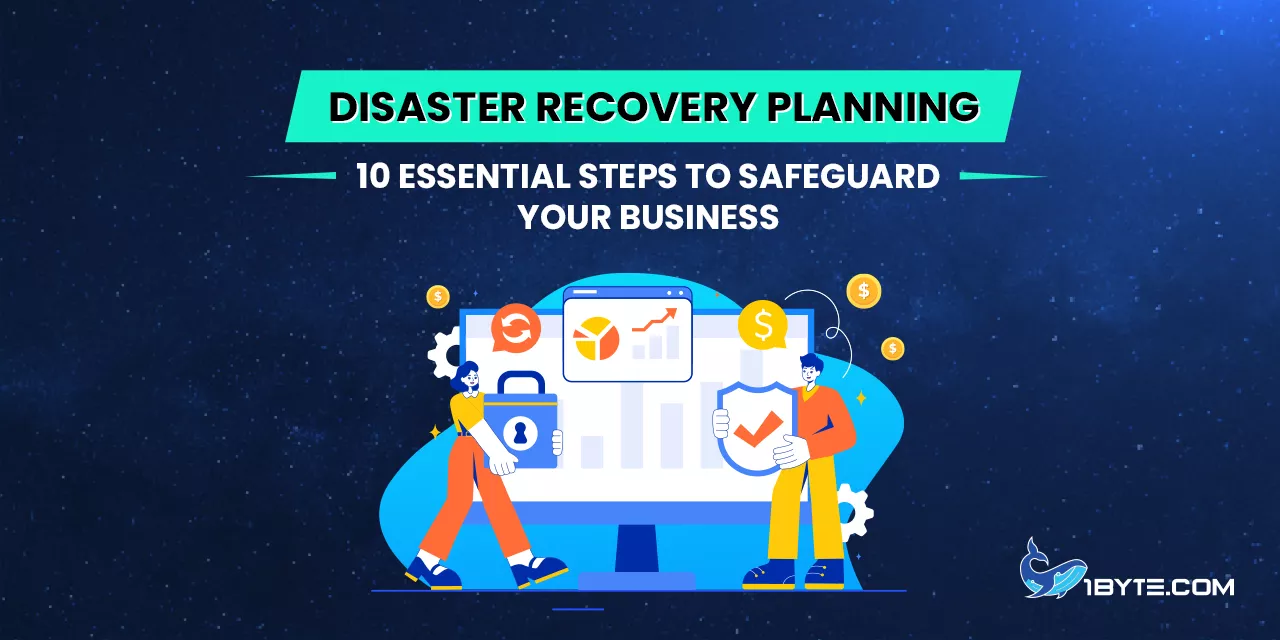- 1. Assess Risks and Impacts
- 2. Define Recovery Objectives
- 3. Document Roles, Processes and Communication Plan
- 4. Implement Data Backup and Redundancy
- 5. Secure Alternate Facilities and Resources
- 6. Train Staff and Distribute the Plan
- 7. Regularly Test and Exercise the Plan
- 8. Maintain and Update Continuously
- 9. Incorporate Third-Party and Supply Chain Risks
- 10. Review and Improve Disaster Recovery Strategy
- Conclusion
Disaster planning protects business operations and data in case of emergencies. Most companies have to deal with unforeseen disruptions. Indicatively, a FEMA report revealed that 40 percent of businesses fail to reopen in the event of a disaster and 25 percent fail to last a year. Recent developments affirm increased risks. In 2024 there were 27 billion-dollar disasters in the U.S. amounting to 182.7 billion. In 2024, natural disasters resulted in damage to the tune of 318billion globally. These events underscore why thorough disaster recovery planning is critical for business continuity. This guide from 1Byte outlines ten major steps that organizations must take to be ready to all forms of crises, whether it is a local fire and flood, or a global cyberattack and pandemic, and all the companies will be able to survive and recover in a short period.

1. Assess Risks and Impacts
The first step is to identify and analyze threats. Companies list potential hazards such as earthquakes, storms, fires, cyberattacks, and even supplier failures. They also consider global trends like climate change or health crises that could affect operations. For instance, 80% of U.S. states recorded ten or more disasters from 2011–2024. Businesses conduct a Business Impact Analysis (BIA) to measure effects. They determine which operations and data are critical, and estimate financial losses for different downtime scenarios. This step sets priorities: it answers questions like how long the business can survive without key systems and what data must be saved. Experts note that while natural catastrophes grab headlines, most downtime actually comes from everyday issues. A recent survey found that errors, hardware failures and cyber breaches cause far more interruptions than natural disasters. An honest risk assessment covers all types of events – not just earthquakes or floods, but also factors like human error and system outages – to ensure nothing is overlooked.
2. Define Recovery Objectives
Then, the organization establishes specific recovery objectives. This includes determining tolerable downtime and data loss of every crucial operation. As an example, leaders can establish a Recovery Time Objective (RTO) of 24 hours on finance system, and Recovery Point Objective (RPO) of 1 hour on customer databases. These measures inform the technical strategy. The value is not lost on many executives: more than half of the surveyed firms intend to invest more in continuity solutions. At this phase, the team identifies resource requirements to achieve goals (e.g. additional servers or backup facilities) and approximates budgets. Being aware of precise targets prevents the use of guesswork in the face of a crisis. It also allows trade-offs: an RTO that is highly aggressive may be paid to have faster backup or high-availability systems; a less critical function may be able to accept a longer downtime. Having clear goals will make sure that all people are aware of the priorities in the recovery situation.
3. Document Roles, Processes and Communication Plan
The plan should be helpful and people must know it. The organization constitutes a recovery team after a disaster and allocates roles. Common positions are a recovery manager, IT leads, facilities coordinator, communications officer, and HR or legal liaisons. Each role has defined tasks. They document the steps one by one: how to declare a disaster, whom to notify, and how the teams are to act. Communication is key. The contact methods (phone trees, text alerts, emails, etc.) are listed in the plan to the employees, vendors and customers. Indicatively, a cloud security report indicated that 100 percent of the sampled organizations lost revenue due to IT outages. Losses and rumours in an outage can be reduced by timely communication. Everything is written in a simple format. The plan should preferably be stored in more than one location (on a safe network and on printed instructions) in order to be accessed even when systems are offline. It is important to have a written disaster recovery plan: studies indicate that 54 percent of organizations possess such a written plan. Setting these rules at this time will equip employees to respond swiftly and decisively when disaster hits.
4. Implement Data Backup and Redundancy
Protecting data is at the heart of disaster recovery planning. Businesses set up regular backups of critical data and systems, using the 3-2-1 rule (three copies, on two different media, one stored offsite). Today many companies use cloud services or offsite vaults for backups; in fact 85% of firms report storing backups in the cloud. They also make redundant hardware for servers and power (e.g. backup generators). Importantly, organizations use multiple backup methods. A study by Veeam found that more than half of all backups actually fail when needed. To avoid this, businesses maintain updated, tested backup infrastructure. Offsite backups are used to defend against site-wide events (such as fire or flood), whereas on-site backups are used to respond to minor glitches. Encryption and versioning assist in making sure that the data is safe and intact. With the introduction of a powerful, multi-layered backup system, businesses are able to avoid data loss and guarantee that they can recover operations at the established RPO.
5. Secure Alternate Facilities and Resources
A main office can be rendered useless by fire, floods or technology failures. In response to this, businesses pre-identify alternative locations and resources. This can be a backup data center, a second office or a remote working policy. As an illustration, a secondary recovery site was only reported by about 20% of the businesses. This is significant to increase this number. Other organizations subcontract co-working areas or mobile command centers which can be called in case of necessity. Others install laptops or cloud desktops to enable the workers to work anywhere. On the same note, essential services such as power and network lines are diversified. Organizations usually have backup generators or two or more internet connections. Planning also involves insurance of key assets (buildings, equipment, vehicles). Insurance is able to cover costs, but not to restore operations on its own. One recovery expert noted that after Hurricane Sandy, affected businesses relied on federal aid and loans, but “insurance money came slow … it covered only a small percentage of losses”. Thus, planning for alternate facilities and supplies completes the foundation for quick recovery beyond mere finances.
6. Train Staff and Distribute the Plan
An action plan will not help when the team is not aware of it. Training of all employees on their roles during a disaster is done. Tabletop and drills simulate outages to ensure that staff practice the procedures. As an example, teams may have a drill that involves disabling a server and checking whether employees can access a backup location. Training focuses on safety (e.g. evacuation routes in a fire) and data management (e.g. how to safely restore systems). Training can help to minimize expensive errors. In fact, a recent survey reported that 69 percent of organizations mentioned human error as a leading cause of downtime. Human errors in a real event are reduced by training personnel about the processes and pitfalls. Contact lists and quick-reference sheets are also distributed in the organization. These materials make sure that when people are stressed, they can get the right instructions and the person to call. The chain of command is known to everyone hence there is smooth communication. Concisely, this step transforms a document into an operational plan by ensuring that the whole team is prepared.

7. Regularly Test and Exercise the Plan
Plans should be tested and revised on a regular basis. To ensure that all the steps of the disaster recovery plan are valid, companies plan regular drills. The tests may be as basic as checklists or elaborate simulations. As an example, IT teams may conduct regular recovery of a backup database to verify that RTO targets have been achieved. Any loopholes or unexpectedness are detected during testing and rectified. Not testing may prove to be an expensive affair: a study has discovered that 32% of administrators never test their backup solutions. Such unproven systems may malfunction at any time of crisis. In comparison, companies that actively test are more successful in the restoration. The results of every test are documented by teams and optimized in terms of procedures. Testing will also remind people about the use of any specialized tools or software. In a world where threats keep on changing every day, testing serves as training of the plan itself. It makes the organization ready to face new challenges.
8. Maintain and Update Continuously
Disaster recovery planning is not a one-time project. The plan needs to be updated as the businesses develop and technology evolves. Companies analyze what worked and what did not work after any test or a real event. Updating of systems and updating of documentation. The continuity investment is something that many firms will be investing more in in the years to come, as they continue to show commitment. To illustrate, certain businesses can relocate more services to resilient cloud systems or implement new backup systems. New business partners, regulations or locations are also taken into consideration by regular updates. Recovery priorities can change with a merger or an expansion of the office. Feedback by employees using the plan is also an important issue to address. By reviewing the plan annually (or whenever conditions change), companies ensure that their disaster recovery planning stays effective. This living document methodology implies that the plan is always up to date with realities.
9. Incorporate Third-Party and Supply Chain Risks
Partners can be a source of disasters. Any failure of the suppliers or any vendor can stop operations. Organizations involve the key vendors and providers in their planning. The contact data of the critical suppliers is gathered in such a way that there is a backup source that can be utilized in case of necessity. The suppliers may be required to have continuity plans of their own. As an illustration, 82 percent of data breaches today include a human factor, and it is prudent to screen the cyber hygiene of partners. In globalized supply chains, the occurrence of events in a given country (such as an earthquake or political unrest) can spread to another country. Flexibility is built and global risks are monitored by companies. This may include the maintenance of additional stock or the identification of alternative shipping paths. By taking these external factors into consideration, the businesses embrace the global situations and indirect disasters. Stability of the partners enhances the whole recovery posture.
10. Review and Improve Disaster Recovery Strategy
Lastly, the leadership conducts frequent strategy and performance reviews. The incident metrics that are analyzed by executives include the number of hours of downtime, loss of data and costs incurred per event. They also follow more general trends; an increase in cyberattacks can make physical calamities less relevant. Leaders in businesses compare results with goals to determine whether goals have been achieved. In case an outage was not recovered in time, the RTO is changed or additional resources are assigned. Organizations also get to learn through the experience of others. Case studies and industry reports indicate what works in other places. As an example, only 39 percent of organizations indicated confidence in their knowledge of recovery, which emphasizes the importance of lifelong learning. By benchmarking and integrating new best practices, the disaster recovery planning process becomes stronger over time. Finally, a mature plan is cyclic: it adapts to the threats and needs of the company, which guarantees its long-term sustainability.
All these measures contribute to the development of a strong disaster recovery system. Companies that adopt them are able to react fast to the crisis, reduce the harm, and get back to work much faster. In the end, effective disaster recovery planning protects not only data and systems, but the very future of the company.
Leverage 1Byte’s strong cloud computing expertise to boost your business in a big way
1Byte provides complete domain registration services that include dedicated support staff, educated customer care, reasonable costs, as well as a domain price search tool.
Elevate your online security with 1Byte's SSL Service. Unparalleled protection, seamless integration, and peace of mind for your digital journey.
No matter the cloud server package you pick, you can rely on 1Byte for dependability, privacy, security, and a stress-free experience that is essential for successful businesses.
Choosing us as your shared hosting provider allows you to get excellent value for your money while enjoying the same level of quality and functionality as more expensive options.
Through highly flexible programs, 1Byte's cutting-edge cloud hosting gives great solutions to small and medium-sized businesses faster, more securely, and at reduced costs.
Stay ahead of the competition with 1Byte's innovative WordPress hosting services. Our feature-rich plans and unmatched reliability ensure your website stands out and delivers an unforgettable user experience.
As an official AWS Partner, one of our primary responsibilities is to assist businesses in modernizing their operations and make the most of their journeys to the cloud with AWS.
Conclusion
Disaster recovery planning is no longer optional. It is an essential business continuity protection strategy in a more threatening business environment. Cyberattacks and climate catastrophes are only some of the risks that businesses have to deal with.
Organizations can be ready to deal with any disruption by adhering to the ten steps described, such as risk assessment to continuous improvement. An effective plan is built on clear objectives, good backups, training of the employees and regular testing. This is further enhanced by the inclusion of third-party and global risks.
Companies that do not underestimate disaster recovery have a significant benefit. They minimize downtimes, protect customer confidence, and bounce back quicker in case of misfortune.
Disaster recovery planning is not just a technical effort—it’s a business-critical priority that ensures survival and resilience in a volatile world.

